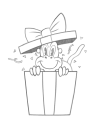$250
LESSON NOTES
Check out the "Assignments" tab to get the assignment details and share your work!
ASSIGNMENTS

Overview
In this assignment, you'll start taking your shading skills to the next level by understanding Ambient Occlusion (AO) at a deeper level.
Materials Needed
- The project image.
- A red colored pencil, or a digital painting application.
Steps
- Download the project file and A) print it out or B) open it in your preferred digital painting application.
- Assuming diffuse light from the sky, indicate in red where you think the occlusion shadows are. Lighter red = less occlusion, darker red = more occlusion.
- When you’re done, check the solutions included in the ZIP file. It contains: A 2D solution with ambient occlusion intensity in red. A 3D render to show you where occlusion occurs and better understand the reasoning behind the red areas in the 2D solution.
Duration
This project should take 15–30 minutes to complete.
Notes


This assignment has evolved over the years, so student submissions below might vary.
Comparing my marks on the assignment with the solution I see some slight differences especially on image 1,2 and 4
It was interesting looking at the difference between ambient light and direct light in this assignment. I think I understand how light and shadow behaves much better now, just by isolating certain characteristics.
There's still some occlusion on objects not directly touching a surface. It's a softer tone, but it's still there.
I graded myself and I have question please from the notes above, is it implying that only ambient light have Occlusion shadow? Because I thought direct light can also have occlusion shadow in its scene.
I think shadows created by direct light are called "form shadow" or "cast shadow". In this assignment we look at AO, and AO refers to "Ambient Occlusion", specifically focusing on the shadows created by ambient light.
Not sure if I'm missing something but I found no 3D version of the worksheet, only a 2D. I see a lot of people here post a 3D version...
I feel that AO is a lot easier to understand intuitively than core shadow.
I got confused a bit too, is this what you were looking for? found here https://www.proko.com/course-lesson/practice-simple-ao-study/downloads
My attempt and the fix after seeing the solution. I wonder why the box concave part has shadows in it? I thought the light source suppose to come from above.. Any feedbacks will be greatly appreciated..













